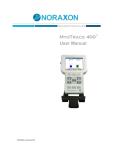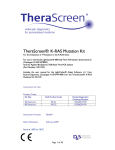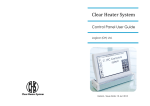Download Wireless In-Home ECG Monitoring System with Remote Access
Transcript
WIRELESS IN-HOME ECG MONITORING SYTEM WITH REMOTE ACCESS Logan Porter, B.S. Thesis Prepared for the Degree of MASTER OF SCIENCE UNIVERSITY OF NORTH TEXAS August 2012 APPROVED: Vijay Vaidyanathan, Major Professor Elias Kougianos, Committee Member Shuping Wang, Committee Member Robert Hayes, Committee Member Enrique Barbieri, Chair of the Department of Engineering Technology Costas Tsatsoulis, Dean of the College of Engineering Mark Wardell, Dean of the Toulouse Graduate School Porter, Logan. Wireless In-Home ECG Monitoring System with Remote Access. Master of Science (Engineering Systems – Electrical Systems), August 2012, 50 pp., 3 tables, 23 illustrations, 35 titles. The thesis work details the design and testing of a wireless electrocardiogram (ECG) system. This system includes a wireless ECG device, as well as software packages to visually display the waveform locally on a computer and remotely on a web page. The remote viewing capability also extends to using an Android phone application. The purpose of the system is to serve as a means for a doctor or physician to check up on a patient away from a hospital setting. This system allows for a patient to be in their home environment while giving health vital information, primarily being the heart’s activity through the ECG, to medical personnel. Copyright 2012 by Logan Porter ii ACKNOWLEDGMENTS I’d like to thank my advisor, Dr. Vijay, for allowing me to work on this project. It has been a great learning experience and I hope this provides useful insights, inspiration, or ideas into new methods of using wireless capabilities for remote health monitoring. Many thanks also to the NI forums for their supportive community in helping me get through various road blocks. I’d also like to thank everyone at Discovery Park who worked with me, for allowing me to do testing and verifying the results of my work. iii TABLE OF CONTENTS Page ACKNOWLEDGMENTS……………………………………………………………………….iii LIST OF TABLES ............................................................................................................vi LIST OF FIGURES ......................................................................................................... vii Chapter I.INTRODUCTON ............................................................................................................ 1 Need for Wireless In-Home ECG Monitoring ............................................................... 3 Scope of Work ............................................................................................................. 4 System Overview ......................................................................................................... 5 Contents of Thesis ....................................................................................................... 8 II.PREVIOUS RESEARCH AND EXISTING TECHNOLOGY .......................................... 9 III.METHODS OF IMPLEMENTATION.......................................................................... 15 Hardware Design ....................................................................................................... 15 Printed Circuit Board Design ..................................................................................... 23 Software Design ........................................................................................................ 25 LabVIEW ................................................................................................................ 26 Database, Web Page, and Scripts ......................................................................... 30 Android Application ................................................................................................ 33 IV.RESULTS OF SYSTEM VALIDATION ..................................................................... 35 Hardware Tests ...................................................................................................... 35 Software Tests ....................................................................................................... 40 System Test ........................................................................................................... 42 iv Comparison Test .................................................................................................... 43 V.CONCLUSION ........................................................................................................... 45 REFERENCES .............................................................................................................. 47 v LIST OF TABLES Table 4.1 - Hardware Tests ........................................................................................... 35 Table 4.2 - Test Measurements .................................................................................... 36 Table 4.3 - Software Tests ............................................................................................ 40 vi LIST OF FIGURES Figure 1.1 - System Conceptual Diagram ....................................................................... 5 Figure 1.2 - Einthoven's Triangle..................................................................................... 6 Figure 1.3 - Electrode Placement .................................................................................... 6 Figure 3.1 - Hardware Block Diagram ........................................................................... 16 Figure 3.2 - Gain Formula ............................................................................................. 20 Figure 3.3 - PCB Block Diagram Layout........................................................................ 24 Figure 3.4 - Fully Constructed Enclosure ...................................................................... 25 Figure 3.5 - Microcontroller Flow Chart ......................................................................... 26 Figure 3.6 - LabVIEW Flow Chart.................................................................................. 27 Figure 3.7 - User Input Prompt ...................................................................................... 28 Figure 3.8 - Blood Pressure Prompt .............................................................................. 29 Figure 3.9 - LabVIEW GUI ............................................................................................ 30 Figure 3.10 - Main Web Page ....................................................................................... 32 Figure 3.11 - Blood Pressure Graph Web Page ............................................................ 33 Figure 3.12 - Android Application Home Screen ........................................................... 34 Figure 3.13 - Android Application BP Screen ................................................................ 34 Figure 3.14 - Android Application ECG Screen ............................................................. 34 Figure 4.1 - Voltage Readings ....................................................................................... 37 Figure 4.2 - ECG on Oscilloscope ................................................................................. 38 Figure 4.3 - Wireless ECG in LabVIEW ......................................................................... 39 Figure 4.4 - ECG Device Placement ............................................................................. 43 Figure 4.5 - Normal ECG............................................................................................... 44 vii Figure 4.6 - Abnormal ECG ........................................................................................... 44 viii CHAPTER I INTRODUCTON The thesis work details the design and testing of a wireless electrocardiogram (ECG) system. This system includes a wireless ECG device, as well as software packages to visually display the waveform locally on a computer and remotely on a web page. The remote viewing capability also extends to using an Android phone application. The purpose of the system is to serve as a means for a doctor or physician to check up on a patient away from a hospital setting. This system allows for a patient to be in their home environment while providing health vital information such as the ECG, to medical personnel. The capacity of wireless technology has increased over the recent decade, introducing new protocols that allow for a multitude of wireless applications. Recent examples of new technologies taking advantage of wireless technology include smart metering by utility companies and sensor networks for building monitoring. The area of health care has many research topics in using wireless technology for potential applications. These extend from wireless vital monitoring to body area networks incorporating multiple sensors on one person that communicate to each other and machines designed to provide ubiquitous health care. [1] In addition to new protocols and devices to allow sensors and computers to communicate wirelessly, smart phones and more recently tablets have emerged as major consumer items in everyday lives. As of 2010, according to a survey, more people have a smart phone than a traditional wire phone. [2] This is especially true with younger audiences. The potential that smart phones and tablets offer through their user 1 created applications has recently become an item of interest in research areas regarding health care. Useful purposes that much research work has been focused on have been in the collection of data, mobilizing health care, and supporting medical healthcare education. [2] The wireless ECG system presented in this work was designed to take advantage of wireless technology and smart phones to allow for a unique application. That application is that a patient can be in their home, but still receive a typical checkup or medical review from a physician as though they were actually at the hospital. The reasons for presenting such an application include making health care mobile, providing convenience to a released patient, and alleviating a physician’s schedule. The wireless ECG system provides mobile health care in that it allows a patient, or user, to be away from a hospital setting. They can be in another building, city, state, or even country. The use of the internet and smart phone allows for this freedom. The availability of internet is the only limiting connection as it serves as a connection to everything else including the smart phone. Convenience is offered to the patient because they do not have to contend with the daily hassles in going to visit a doctor. This includes commuting and waiting. Additionally, they are not limited to return visits to receive feedback from a doctor. The system also allows for the alleviation of a doctor’s schedule by allowing them to use a smart phone to view information. This can allow for a “on the fly” type of approach. Therefore, a doctor will not be bogged down by visiting a room or trying to find a patient. 2 Need for Wireless In-Home ECG Monitoring When a patient is in a hospital, they are surrounded with near constant care. This includes nurses and machines to monitor the patient’s health. If a problem arises, it can be detected and appropriate action can be taken in a timely manner. When a patient leaves the hospital, the availability of health monitoring can drop dramatically. While at home, the patient will not have the same level of care as they did at the hospital. The patient’s own knowledge of their condition is required to help them diagnose themselves and determine when they are not feeling well. Machines exist to assist with self-monitoring, such as blood pressure and pulse oximetry devices, but it is up to the patient to determine the results. Due to this, a patient is not as likely to know the subtle negative effects that are happening to them. Another potential issue is that the doctor responsible for the patient has no personal touch with the patient while they are away from the hospital. Visibility to the patient’s health is limited to return visits or phone call. Due to the limited monitoring methods while at home, problems that can occur might not be detected until the patient has been affected adversely. These problems create a need for better in-home monitoring. A system that could allow for a doctor to view data on a patient remotely can increase the likely hood of detecting declining health before it becomes a serious issue. The work in this thesis concentrates on a design to help address the need for better in-home monitoring. Since the patient is at home and not confined to a single room as in a hospital, a wireless solution is most beneficial to the patient by allowing more freedom and range of motion. An ECG expresses the activity of the heart as an electrical signal throughout the 3 cardiac cycle and can visually depict a state of condition for the patient through a graph created from the ECG.[3] Therefore, it serves as the main vital to be monitored by the wireless system. Scope of Work The scope of the thesis work includes designing the hardware and software components necessary to capture an ECG signal and allow for it to be remotely viewed via web page and Android phone application. The hardware consists of the ECG device itself. The following are the functional requirements of the hardware: • Use three electrodes to measure ECG • Amplify and filter ECG to make comprehendible • Transmit ECG wirelessly • Enclosure is compact, portable, and does not limit user movement • Provide sufficient battery life for user The software includes components necessary to graph the ECG waveform, save measurements to a database, allow user inputs, and use a web page to show ECG graph and user information. The functional requirements are summarized as follows: • Graph ECG data and display on Graphical User Interface (GUI) • GUI allows for entry of user information • Incorporates database to save user information and ECG data • Displays database information to web page • Displays ECG graph to web page The Android application is also part of the software and has the following functional requirement: 4 • Act as remote interface to view patient data and ECG graph The functional requirements of the hardware and software are verified through the testing of the system. The tests and results are found in the test results section of the thesis. System Overview The system is designed to be used by a person in their home environment employing a wireless ECG device. A LabVIEW program is created to collect, graph, and store the data to a database. The database is used to make the data interactive with a web page and an Android phone application. Figure 1.1 shows a conceptual diagram of the system. Figure 1.1 - System Conceptual Diagram The ECG device uses a three electrode approach based on the Einthoven triangle for detecting electrical activity of the heart. [4] This triangle uses three bipolar limb leads, which include the left arm, right arm, and left leg. The axes of the three limbs form an imaginary inverted triangle around the heart. The sum of any of voltages in whichever closed path of the triangle equals zero. The zero potential created by the vector sum of the voltages creates a virtual ground used as a reference point for the 5 leads. The center of the triangle is the reference point, in this case being the heart. Figure 1.2 shows an example of Einthoven’s triangle and the axis of each lead. Figure 1.3 depicts how the ECG electrodes are set up on the human body with the red electrode being the positive lead, black being negative, and white as the ground lead. Figure 1.2 - Einthoven's Triangle Figure 1.3 - Electrode Placement Due to the amplitude of the ECG being very small and associated noise, an amplifying and conditioning circuit is implemented to help produce a signal that is comprehensive and usable. A microcontroller is used to sample the measurements and transmit them to a wireless radio unit. The wireless transmission is achieved using the Zigbee protocol. This allows for wireless communication at 2.4 GHZ with ranges up to 133 feet. [5] Zigbee is used over Bluetooth due to its superior range and better propagation through obstacles that block 6 RF signals such as walls. Using Zigbee allows a user more mobility in their home environment than Bluetooth would. LabVIEW is implemented for the collection of data from the ECG device. LabVIEW allows for a creation of automated measurement systems with hardware integration. [6] Therefore, it is an ideal program to use due to its functions designed specifically for hardware integration. The main purpose of the LabVIEW program created is to record the ECG data real time, graph the data locally, and move it to a database. Additionally, a user can input basic information and other vital records such as blood pressure to be uploaded into the database. The database records the ECG data, patient information, and other vitals entered from LabVIEW. The database consists of different tables for the ECG data and patient/other information. This is necessary due to the data types and implementation of interfacing the database to the web page. The database is implemented with MySQL because it is a popular open source database system that allows easy integration with web page script programming. [7] Development costs are also minimized with the implementation of MySQL. The web page is simply a visual representation of the database and is one method for remote monitoring. PHP is implemented for the scripting of the web page as it is a widely used server side scripting language that can be embedded within HTML with support for MySQL databases. [8] The Android phone application is another method of remote monitoring, and performs as an interface to the web page should someone doing the remote monitoring be away from a typical computer internet connection. The use of a phone allows for the remote monitoring capability to extend to wherever cell phone service is available. The 7 Android platform is selected because of its open source nature and great availability through all major and minor cell phone carriers. Contents of Thesis The chapters that follow are classified as: Previous research and existing technology – In this chapter, works in academia and industry are compared to the accomplished thesis work. This chapter shows how the thesis work is different than what exists today. Implementation – The chapter describes how the system was implemented from both a hardware and software standpoint. Specific details relating to how electric components are connected are addressed, as well as software specifics such as flow charts, code, etc. Results of system validation – The tests done to verify functional requirements and their results are discussed in this chapter. All hardware and software tests are explained from component to system level. Limitations found in the system during testing are described as well. Conclusion – The results of the work are summarized in this chapter. This includes evaluating the system as a whole and addressing matters found in testing 8 CHAPTER II PREVIOUS RESEARCH AND EXISTING TECHNOLOGY This chapter describes an overview of previous works that have been done commercially and academically in the filed of wireless vital monitoring. Works done in both fields are compared to the thesis scope of work to help determine what innovation and novelty the thesis introduces in wireless vital monitoring. Commercial products for wireless heart monitoring date back to the invention of the wireless heart monitor introduced by the Finnish company Polar Electro in the 1970s. Polar monitors incorporated wireless technology and ECG monitoring techniques to monitor heart rate and display it to a handheld watch. This allowed athletes to know their heart rate during exercises. However, this was the only intended function and it was not sought to be used as a complete ECG monitor. Current heart rate monitoring products by Polar, BMInnovations, Garmin, etc. are still primarily used for exercise purposes. While high end products of these incorporate software that replicates a small ECG waveform, these products are not suited for extensive monitoring as the primary function is to indicate heart rate to determine if an individual is exercising past the body’s capability. Additionally, they can cost several hundred dollars for a high end model and are exclusive to only intra brand heart monitors, i.e. one cannot interface a Polar with Garmin. The thesis work is not an exercise heart monitoring device and does not fall into the same category as these products although both types of devices are capable of wireless functions revolving around the heart. Beyond simple exercise heart monitors, medical technology companies exist that make wireless ECG monitoring solutions and software packages. Most products made 9 by these companies are aimed at hospitals and academic research. Some devices incorporate only ECG, such as Alive Technologies heart and activity monitor. [9] Others incorporate ECG, brainwave activity, and other biometrics. An example is Great Lakes Neurotechnologies BioCapture. [10] Examples of hospital units include Schiller’s wireless monitor unit capable of printing out an ECG reading on ECG paper [11], and LifeSync’s wireless system that was first implemented in intensive care units in Mercy Hospital in Miami, Florida in 2004. [12] The products described have great capabilities. BioCapture can measure more than an ECG signal and comes complete with monitoring software. Custom software can even be developed using LabVIEW and MATLAB. However, the extensive measuring, customizability, and high price point starting at $6,000 makes the audience for the device very small even for those within medicine and academia. Schiller and LifeSync products also contain high price points in the thousands of dollars and are not suited for home use. The Alive Technologies product, Alive Heart and Activity Monitor, is designed more for the general consumer. As described by Alive Technologies, it is for “screening, diagnosis and management of chronic disease, and for consumer health and fitness.”[9] The Alive Heart and Activity Monitor uses 2 electrodes connected to a small enclosure that can fit in a pocket. The enclosure can communicate via Bluetooth to a phone, PDA, or PC. The device displays both ECG and heart rate. Additional options include GPS, speed, and location tracking. The software package allows for saving ECG data and heart rate activity. 10 This product is similar to the work achieved in the thesis. It incorporates a wireless ECG, displays to a phone or PC, and keeps a record. There are differences between the Alive Technologies product and the thesis work. The Alive Technologies product uses the phone as the primary data recorder using Bluetooth, sending data from phone to server. The thesis work uses a computer, to send to a server, as the data recorder, implementing Zigbee to give greater range over Bluetooth. Using a computer will allow for more powerful graphing applications, processing power, and won’t be limited by phone data usage plans. The thesis work allows for additional user inputs, such as blood pressure and basic medical information to be displayed on a web page. Alive Technologies product is more geared towards exercise monitoring in its additional features incorporating features such as user speed and GPS. Although the features may seem very similar at a glance, the application and implementation between the thesis work and the Alive Technologies product are enough to make the thesis work unique and different. In evaluating commercial products, they can achieve functions presented in this thesis work. The Alive Heart and Activity Monitor caters more towards a general audience and works as a monitoring device, but is more suited towards an exercise application with its additional features. Commercially, this thesis targets the general population by providing a low cost system capable of on-site monitoring and capable of monitoring additional parameters. Many articles have been published over the last decade describing different implementations of a wireless ECG system and different functionalities. These range from having ECG probes connected to PDA’s, sending ECG signals via Bluetooth, 11 developing wireless monitoring networks, and recent research has incorporated smart phone apps. [21] Research has shown that wireless communications has facilitated monitoring of vitals with minimal interfacing to the patient. Previously, wires and machines had to be close to the patient, but now the patient can be cleared of wires between them and the machines used to monitor them. The use of wireless technology has allowed for efficient, ergonomic monitoring. The advances in technology and research in wireless technology has allowed for compact wireless devices to be used. The technology has enabled sending over longer distances, incorporation of sensor networks, and interfacing to handheld devices. Multiple ECG systems have been researched and developed using wireless technology. [13], [14], [15], [16], [17], [18] Bluetooth was the primary method of sending information to a central PC, PDA, or phone. Other methods included using SimpliciTI, a Texas Instruments wireless protocol, and IEEE 802.15.4. The PC is used to save ECG information and transfer it to medical personnel. The method of application was the same, to send ECG information wirelessly to a central machine and have it transferred to appropriate personnel. The implementations were different across the research areas. These included designing custom boxes, or attaching small development boards to ECG probes. The ECG waveform varied between all the research works. All contained parts of the QRS complex as well as different parts of the P and T wave. Other research has tried to incorporate multiple vitals to monitor in one system. [19] This system monitors ECG, blood pressure, and oxygen saturation. The type of sensors used was not made clear, but it was stated that continuous information was 12 sent from each sensor. Bluetooth was used to transmit information to a PC. A GSM interface was used to transfer the patient’s information to the clinic’s server which is accessible through a PC. Additional research also incorporated multiple vitals wirelessly. [20] A cuff less blood pressure monitor was constructed and estimated blood pressure based on pulse transmit time and events in the cardiac cycle. Though successful at proving the concept, the level of error in the blood pressure estimation was a point of future work. At a glance, these appear very similar to the proposed thesis work. However, both systems have limited range and penetration through walls, etc. Zigbee will allow better wireless transmission. Additionally, the remote viewing is limited to a PC. In contrast, this thesis uses a smart phone as a remote viewing device. Additionally, the implementation and application of this thesis is different than the previously mentioned systems. As of now, this thesis only incorporates ECG, but future expansions of the work will try to accomplish similar results for other vitals. The advancement in mobile devices such as cell phones, has also gained momentum in academic research. The use of mobile devices has allowed monitoring to become movable, portable, and flexible. Monitoring a patient is no longer limited to a room connected to a machine. Individuals can now be monitored within a floor, building, or even outside due to the capability of mobile monitoring. Research in mobile vital monitoring has noted that the ability to be mobile and portable will become more important in the future. A phone application was developed in [21]. ECG information was sent via SimpliciTI to a gateway attached to a computer. The gateway transmitted data via 13 Bluetooth to a smart phone and the ECG could be viewed in real time on the phone. This research showed the feasibility of using new generation smart phones for data display. Another smart phone application was used by [22] developed an application to use with a smart fabric shirt made by Biodevices. This application monitored vital signs of emergency response teams and included GPS tracking. ECG was one of the primary vitals monitored. This research showed the usefulness of using a smart phone in vital monitoring and suggests other markets of potential research, emergency response personnel. The use of smart fabric also shows potential future products that can be incorporated with vital monitoring. All academic research shows that mobility and advances in wireless technology is the new future of health monitoring. The use of smart phones and being mobile is becoming more important as telemedicine gains popularity. Potential markets based on academic research include at home systems and emergency response teams. ECG is an important vital for monitoring, as it was the key input to all systems. The thesis work shows a unique application and potential market which previous work has already demonstrated potential in. 14 CHAPTER III METHODS OF IMPLEMENTATION Specific details of the hardware and software used to design and to construct the ECG monitoring system are presented in this section. As described previously, the system consists of an ECG device which transmits data to a PC and incorporates software to graph the data, allow for user inputs, save to a database and be displayed on web page, and allow for an Android phone application to access the web page for remote viewing. The hardware design discusses all components used to construct the physical ECG device including the circuit board layout and its components. Details of circuit analysis for components are also addressed to describe further why specific circuit elements were selected. The software design discusses software programs implemented along with an explanation of software logic through flowcharts. Also described are program functions and the specifics of what they accomplish. The LabVIEW GUI, database, and the web page are all detailed in software design. Hardware Design The hardware consists of the circuitry used to build the wireless ECG device. The block diagram in figure 3.1 presents a high level overview of the hardware and its connections. 15 Figure 3.1- Hardware Block Diagram As seen in the block diagram, there exist different blocks. These blocks each represent a major portion of the hardware. Included are the battery recharge, undercharge protection, power, amplification, filter, microcontroller, and Zigbee. The battery recharge and power blocks deal with powering the device and recharging the battery. The amplification, filter, microcontroller, and Zigbee blocks are the heart of the ECG device and deal with taking an ECG signal and making it coherent for transmission. The output from each block is the major signal associated with that component that is required for the next one. The power block consists of the voltage regulating circuit to provide DC power to the rest of the ECG device. The first part of the circuit consists of a 3 V low-dropout (LDO) voltage regulator, and the required regulating capacitors. The capacitors are required to filter incoming and outgoing DC voltage to prevent as much ripple as possible. A LDO regulator is capable of maintaining regulation with small differences between supply voltage and load voltage. [23] The input voltage needs to be only a few hundred millivolts above the output. This helps to maintain system voltage independently of the battery charge. Therefore, the system can continue to operate as the battery becomes depleted. A 3 V regulator is used because this is the highest of the 16 minimum operating voltages. The Zigbee radio is limited by its operating voltage. It cannot operate below 3 V. The specific component was selected due to its small size, supply current, operating voltage, and its specific function for small devices. The small packaging allows for a minimal footprint on the printed circuit board as it is a surface mount package type. The current amount provided by the voltage regulator provides plenty of head room should more current be required due to the microcontroller functions. The input voltage to the regulator comes from a 3.7 V one cell lithium polymer battery. A lithium polymer battery allows for an increased battery life over conventional AA or AAA batteries, while using one battery instead of several to achieve a voltage above the LDO dropout. In addition the lithium polymer battery is rechargeable and comes in a small form factor, therefore reducing the footprint needed in the enclosure. A concern when using the battery is protecting against under charge and over charge. If the battery is discharged too much, it can be damaged and not function properly. Similarly, with over charging the battery, it can damage the battery. To help prevent this, the battery pack selected has built in under and over charge protection. The battery is rated for 400 mAh with a 2C rating. Therefore, using the estimated supply current, the device’s calculated operating time is about 6 hours before it needs to be charged. The actual battery life is discussed in the testing chapter. The second part of the power component is the integrated circuit used to provide negative 3 V DC to the operational amplifiers negative rail voltage inputs. The negative voltage is required so that the negative element of the ECG signal can be amplified and filtered. To accomplish this task a special purpose IC is used. 17 The IC chosen is a switch capacitor voltage converter. The operation of the device works primarily by switching between two capacitors. The first capacitor charges to the input voltage on the first half of the switching cycle. During the second half of the switching cycle, the voltage is inverted and applied to the second capacitor connected to the load. The switching is controlled by an oscillator internal to the IC. The oscillator frequency controls the ripple of the output and affects the size of capacitors needed. [24] Capacitor values chosen were based on the application notes in the data sheet. The battery charging block consists of a simple IC designed for charging single cell batteries. This IC takes a DC voltage from a USB power source and supplies current into the battery to begin charging the cell. The only external interfaces are the required capacitor on the inputs and outputs as specified by application notes in the datasheet and LEDs to indicate USB voltage is supplied and that the battery is charging. When the battery is charged, the IC goes into a low current mode to prevent overcharge. Although undercharge protection is implemented in the battery itself, an additional circuit is incorporated to help protect against undercharge. This is accomplished through the use of an IC. This device is a comparator that compares the battery’s voltage to a reference. The reference voltage is 0.5 V, obtained using a voltage divider. When the battery voltage reaches 2.7, then the IC outputs a logic zero by sinking current. If the reference voltage is not reached, then the output is high. The output is connected to the shutdown of the voltage regulator. The shut down is active low and turns off the voltage regulator making it act as an open circuit. This shuts off all other components and reduces further current drain on the battery. When the battery is 18 charged and the reference voltage is exceeded, a logic high is sent to the shutdown pin, turning the voltage regulator and other devices on. The amplification block consists of the amplifying circuit necessary to start producing a usable ECG signal. The ECG signal is the difference in potential between the positive and negative electrode. This potential is very small and contains noise due to its small magnitude and external factors such as other muscle movements and power line interference. As a result, an instrumentation amplifier is necessary. The instrumentation amplifier is a special purpose circuit that consists of three different operational amplifiers (all combined on a small integrated circuit), which are two buffered inputs connected to a differential amplifier. The main operation of the instrumentation amplifier is to take two differential inputs, obtain the difference between them and amplify the signal according to a specified gain. Another feature that makes the instrumentation amplifier necessary is that it rejects most common mode noise. This is known as the common mode rejection ratio (CMRR). CMRR is a measure of a device to reject input signals common to both inputs of the device. This is extremely useful when the input signal is represented by a small voltage which is placed over a voltage offset, or when data is contained in a voltage difference between two signals. The ECG data is contained in the difference of the inputs, so a good CMRR is important. The voltage buffers contained in the instrumentation amplifier are used to create high impedance inputs. This allows for using the instrumentation amplifier with high resistances at the source, i.e. high resistance leads, while still obtaining a low error at the input. This helps reduce any loading effects. Another advantage of voltage buffers is 19 that source resistances can be unbalanced with no degradation in the CMRR. This is helpful with varying lead lengths. [25] The gain is set so that the ECG signal is visible within the rail voltage limits of the instrumentation amplifier and takes advantage of using the full scale range in the analog to digital (A/D) converter on the microcontroller. The gain is specified by the given formula in figure 3.2., where RG is a resistor value. G = 1 + (50kΩ/RG) Figure 3.2 Gain Formula This gain value was found through observing a test waveform on an oscilloscope output and adjusting the gain to the rail voltage limits. The filter block contains the filters necessary to reduce noise and prevent baseline wondering in the ECG signal. The filters implemented are active filters. Active filters incorporate operation amplifiers and help to isolate input from output. This is useful for multistage filters to keep the amplitude of the signal from degrading. [26] The filtering circuit contains two different filters, a low pass and high pass. The low pass filter uses the amplified ECG signal as the input. The low pass filter is designed to cut off high frequency noise associated with the ECG and external interference. Much of the key components for an ECG are found in the frequency range between 0.5 to 100 Hz. [27] Additional interference is caused at 60 Hz from power line interference. This is due to lighting and other electronic devices operating on AC power at 60 Hz and the human body acting as a coupling capacitor. The result is interference current. [27] Therefore, the low pass filter must attenuate any interference at 60 Hz. 20 Taking these two parameters into consideration and through testing, a low pass filter was designed. After high frequency and 60 Hz noise are removed, the signal passes through another active filter which is a high pass. The high pass filter is used to help eliminate baseline wandering. Baseline wandering is when the ECG signal appears to drift from the reference line on a graphical display. It is caused by low frequency movement in a person. [28] In addition, the high pass filter eliminates any DC offset carried over from the instrumentation amplifier. The last circuit in the filter component doesn’t involve a filter, but is necessary to condition the signal for the microprocessor to use. The microprocessor’s analog to digital converter cannot operate with negative voltages. The ECG signal up to the current point contains a positive and negative component, the R and S wave respectively. To eliminate the negative component while keeping the S wave signal intact, a DC offset is applied. The DC offset shifts the waveform “up”. This means that the reference for the waveform is no longer at zero, but at the value of the DC offset. The DC offset applied was 1.5 V, or half of Vcc. This is because the peak of the R or S wave is 1.5 V, therefore its peak to peak range is from 1.5 V to -1.5 V. Adding a 1.5 V offset shifts the peak to peak range to 3 V to 0 V allowing the entire waveform to be contained within the limits of the analog to digital converter. Once the ECG signal is amplified and conditioned, it is then passed to the analog to digital converter (ADC) of the microcontroller. The purpose of the microcontroller is to digitally convert the ECG signal and output it to the Zigbee radio unit as UART 21 (universal asynchronous receiver/transmitter) data as well as accept and process requests from the LabVIEW GUI. The microcontroller used is an AVR microcontroller in the ATMega chipset. This is an 8-bit processor with a 10-bit successive approximation ADC capable of 15 ksps at maximum resolution. [29] The ECG frequency is not in a high frequency range. Therefore, the ADC on the microcontroller is more than capable of sampling the ECG signal as long as the conditions for Nyquist Theorem are met. The Nyquist Theorem states that the sampling frequency should be at least twice as high as the largest frequency contained within the signal to avoid aliasing, or distortion. [30] The ATMega is configured to read a sample about every 100 us, resulting in a sampling frequency of 10 KHz. The ATMega contains one UART channel. This is required to interface with the Zigbee because the Zigbee transmits and receives data through UART frames. The UART channel is configured with a baud rate to setup how fast information is transferred. The baud rate determines how many symbols per second are transferred. This is not the same as bits per second, as a symbol may contain multiple bits. [31] The Arduino is setup for 57600 bits per second, with one symbol containing 10 bits that include a start bit, stop bit, and 8 data bits. The resulting baud is 5760. The ATMega328 contains additional digital input/output (I/O) pins that are used to interface with LEDs for testing purposes. The programming pins are also connected to a header to allow for an AVRMkII ISCP (In Serial Circuit Programmer) to be used to flash a program in the memory of the microcontroller. 22 The Zigbee component is only the Zigbee radio unit, being an Xbee module made by Digi International. The module has a built in Zigbee radio and antenna network in one device operating in the unlicensed 2.4 GHz frequency band with a range up to 133 ft. depending on line of sight and transmission power of 1.25 mW. [5] The device is configured to the same baud rate as the microcontroller to keep the messages between them in sync. Since only two units are used, one for the ECG device and another as a transceiver on the PC, default settings for transmission addressing are used as provided by Digi International. Additional test LEDs are attached to the Xbee for testing purposes to verify data is transmitting and receiving. Printed Circuit Board Design A printed circuit board (PCB) is constructed and populated with all the components of the ECG device. In designing the PCB, space and layout are the largest factors to consider. The size of the PCB is limited to the enclosure that must be portable. This affects the footprints and spacing of components. All components are surface mount, except for headers, the battery connector, and test points. The PCB was drawn with National Instruments Ultiboard. Before laying out the drawing for the PCB, an enclosure had to be selected. The enclosure selected measured 3.8” x 2.4” x 1.0”. This is approximately the size of an average cell phone, being slightly thicker. The layout of the board began with sizing the board outline to the lay in area of the enclosure as specified by its drawings. After sizing the board outline, the components need to be placed in a way that would allow for easy soldering, access to 23 pins for external connections, and easy trace rout drawing. Figure 3.3 shows the block diagram for the board layout. Figure 3.3 - PCB Block Diagram Layout The components dealing with the battery such as the recharge, undercharge, and power are placed in the lower left corner of the board. This is due to the physical location of the battery underneath the board. Grouping these components together close to the battery helps to reduce trace counts, trace length, and clutter. The amplification and filtering are set at the top of the board, as this is where the connection to the ECG probes comes from. The ECG connection is a headphone jack with three leads for each probe. The amplification and filtering are not placed directly below the ECG probe connection because of the necessary keep out zone for the Xbee unit. In the keep out zone, no metal traces or components are recommended to be contained with in it due to the possible interference with the antenna. [5] 24 The microcontroller is placed in the middle of the board because it has connections from and to other components, test points, LEDs, and the programming header. The middle of the board allows for the most space and easiest access to the required pins for trace routes and soldering. The Xbee module is kept away from other components to keep interference from them to a minimal during transmission and receiving. The keep out zone on the PCB is located beneath the Xbee antenna across the entire board. Once the PCB was constructed, it was placed inside the enclosure and appropriate holes were made to mount the switch and headphone jack for the ECG probes. The completed enclosure is shown in figure 3.4. Figure 3.4 - Fully Constructed Enclosure Software Design The software design consists of three major components which include the LabVIEW GUI, web page with its associated databases and scripts, and the Android phone application. The LabVIEW GUI serves as the interface to the hardware and user. In addition, it forwards information to the appropriate database so that the information can be graphed or displayed on the web page and Android application. 25 LabVIEW The ECG device communicates to LabVIEW via the XBee module. Commands to the microprocessor are issued from LabVIEW and results of the commands are then sent back from the microprocessor. To achieve the functionality of allowing LabVIEW to control the microprocessor, a special library was incorporated called LabVIEW Interface for Arduino (LIFA) from National Instruments. This library contains two parts, a program that is flashed onto the microprocessor and the LabVIEW commands. The program loaded onto the microprocessor allows for recognizing and interpreting commands issued from LabVIEW. Within this program, the communication rate is set to match the XBee modules (57600) and an analog reference is defined for the ADC (3 V). The program is flashed into memory using the AVRMkII ISCP via the Arudino integrated design environment (IDE). The microcontroller flow chart is shown in figure 3.5. Figure 3.5 - Microcontroller Flow Chart Constructing the LabVIEW GUI contains two stages. The first is setting up the programming blocks with specific commands. The second is constructing the interface and display for the user. LabVIEW programs via blocks that execute various 26 commands. [6] Therefore the programming is graphical. The functions of the GUI are defined within the functions window, while the GUI display and interface are designed in the control window. The LabVIEW GUI operates according to the flow chart in figure 3.6. The programming blocks are set up to allow LabVIEW to function in the desired manner. Figure 3.6 - LabVIEW Flow Chart To keep the program continuously running, except when it is terminated by a user, a while loop is used. All operations take place in the while loop. This loop operates every with a several ms delay to prevent overloading the CPU on the user’s computer. The connection to the microcontroller is established through opening a connection defining the COM port and baud rate. The COM port is the USB port containing an XBee module defined through the PCs device manager. Once this is established, all other LIFA functions will connect to it so that they know how to communicate with the microcontroller. 27 The ECG signal is sampled on an analog pin of the microcontroller. This is specifically analog pin 1, so a LIFA function is made to read analog pin 1 and the output from the function is taken to a waveform graph. The output type is a type double as specified by LabVIEW and connected to a one dimension array which is required to display the waveform graph. The user inputs are entered through the use of a prompt. This prompt is achieved through an express virtual instrumentation (VI), or a premade function. A separate prompt is used for both blood pressure and basic medical information of the user. These prompts are activated by a button connected to a case statement. When pressed, the button outputs a logic true activating the prompt contained in the true case statement. If not pressed the button outputs a logic false. This activates a waiting state, which leads to the prompt not being open. Figure 3.7 and 3.8 show the user input and blood pressure prompts. Figure 3.7 - User Input Prompt 28 Figure 3.8 - Blood Pressure Prompt Both the ECG waveform and user inputs are saved to a database. This is achieved through an open source program called LabSQL. The library allows for interfacing LabVIEW to any database through SQL statements. [32] A connection is first established with the database specifying driver types, username, password, and database name. Once the connection is established, an SQL statement is executed. After the execution of the SQL statement, the connection is closed. The SQL statement used for inserting ECG data into a database is an update command. An update command overwrites previous values, while an insert command inserts a new row. A new row is not necessary, because only one value is needed at a time instead of a series of data points. In order for the SQL statement to execute, the data must be formatted as a string. This is because the SQL statement itself is a string to the SQL execute function. Although the data is formatted as a string in LabVIEW, it is kept as a type double when inserted into the database due to the database variable holding the value being defined as a double. Saving the user information and blood pressure incorporates the same approach to save the information to a database. Variables, or inputs, are tied to a SQL execute function via string formatting. An update statement is implemented since the user will 29 only be changing existing values. The SQL execute function works only when the case statement is true. The user interface is constructed by arranging objects so that graphs, buttons, and texts are in logical positioning and readable. The user interface, along with an example ECG waveform is shown in figure 3.9. Figure 3.9 - LabVIEW GUI Database, Web Page, and Scripts The database and web pages with necessary scripts were developed using MySQL, HTML, JavaScript and PHP. MySQL is an open source database program on a server that allows for operability on a number of systems and with multiple applications. [7] HTML is a standard coding for web pages [33], and PHP is a type of coding for server side scripts. [8] An HTML page calls a PHP script from the server to request information. For the thesis work, the HTML pages call a PHP script to access the database. JavaScript is incorporated in the HTML to draw the ECG graph. 30 The database contains the ECG data and user information in a series of tables. There is a separate table for ECG, blood pressure, and medical information. The ECG table is defined with two columns, an ID and the value of the analog pin. The ID serves as a tag to identify what row to update with the update SQL command. The blood pressure table has an ID tag as well as systolic and diastolic values. The medical information has an ID tag, name, age, weight, height, allergies, medications, and comments fields. In order to obtain information from the database to make visible on the web page, a PHP script is incorporated because it is a server side code and will allow for easy calling of the database. There are different scripts to retrieve the values of each table. All scripts contain the standard code to connect to the database. This includes the username, password, database name, and database location. All scripts also query the appropriate table by saving the data from the table to a variable array. The scripts return the appropriate values from the variable array according to what is being requested. The script retrieving the ECG variable differs slightly in its function in how it returns the variable. It must be returned using the function json_encode( ). JSON, JavaScript Object Notation, is a lightweight data-interexchange format that is easy for machines to parse and generate that is language independent, so it is not bound only to JavaScript. [34] The encode function is required in order to format the variable as an appropriate value to be used with the JavaScript for graphing. The graphing functions are achieved through a library called FLOT. FLOT is a specific library designed for jquery, a library for JavaScript designed for handling web interaction. [35] The graphs included are blood pressure and the real time ECG graph. 31 The real time graph works by using a json function to retrieve the ECG number from the database, saving it to a Y-axis variable, and plotting. The X-axis is incremented by one each time a new Y-axis variable is retrieved. This continues until 100 data points are filled. Once filled, the oldest entry is deleted so that the newest data point can be inserted. This creates the appearance of a moving real time graph. The blood pressure graph is simply a bar graph of the blood pressure table values. The created HTML page took all the PHP scripts and necessary JavaScript functions and incorporated them into one page that was viewable through an internet browser. Figure 3.10 through 3.11 show the HTML pages created. Figure 3.10 - Main Web Page 32 Figure 3.11 - Blood Pressure Graph Web Page Android Application The Android application serves as a remote way of observing information from the databases through the use of mobile broadband. This helps make the application of remote monitoring possible. The application was constructed in App. Inventor from the MIT Center for Mobile Learning. App Inventor allows for graphical programming verses standard coding. This helps to simplify and speed up development. Additionally, a phone emulator is provided to test applications. First, the layout of the phone was made. This included designing the buttons and attaching a web viewer to the application. The web viewer accesses the HTML pages designed for the application. The buttons include ECG, blood pressure, and medical information. Once the layout was designed, the functionality of the buttons was programmed. The completed layout is shown through the emulator in figure 3.12 through 3.14. Button functionality was programmed using the blocks editor exclusive to App Inventor. The blocks specified the actions, in sequential order, that were to be taken 33 when a button was pressed. The actions included highlighting the selected button and retrieving the appropriate HTML page. Figure 3.12 - Android Application Home Screen Figure 3.13 - Android Application BP Screen Figure 3.14 - Android Application ECG Screen 34 CHAPTER IV RESULTS OF SYSTEM VALIDATION The purpose of testing is to ensure that functional requirements are met. This includes at the individual component level and when everything is combined together at the system level. All tests done are recorded and results are given. Tests are categorized as hardware, software, system, and comparison tests. Hardware Tests The hardware tests include testing all the blocks mentioned in the hardware implementation. These tests are done independently first before connecting another component. The following tests are indicated in Table 4.1. Table 4.1 - Hardware Tests Test Type Functions To Test Power Regulated 3 V output, - 3 V output Undercharge Protection Turns off voltage regulator when low battery Battery Recharge Supplies current to battery to recharge Amplification Amplifies ECG signal to within limits of rails Filter Filters ECG to make signal viewable Microcontroller Programs correctly, reads analog pin 1, interfaces with LabVIEW Zigbee Transmits and receives to microcontroller, range The power component test first ensures that the voltage regulator is working. This was done by connecting the battery and measuring voltages at various test points. The reading for the regulator output was 3.1 V, well within the specified data sheet limits 35 and suitable for all ICs used on the PCB. Next, the negative voltage converter was tested. The input was the 3.1 V and measured was a – 2.99 V output. This was acceptable for the operational amplifiers used as a 0.11 V difference is not significant. The following table 4.2 shows the test measurements and readings for the power component. Table 4.2 - Test Measurements Measurement Reading regulator voltage output 3.1 V switch capacitor voltage converter output - 2.99 V Comments Within limits and suitable for all devices Difference of .11 V, not significant difference for negative rails on operational amplifiers The undercharge protection circuit was tested by adjusting a voltage source from 3.7 V to 2.7 V and observing the voltage reading on the output of the comparator IC chip, shutdown of the voltage regulator, and output of the regulator. Readings showed that when the input voltage was at 3.7 V to above 3 V, the output from the comparator was a logic high, the same as voltage source, and that the voltage regulator continued to operate. However, once the voltage reached 3 V or below, the output from the comparator was 0.06 V, activating the shutdown of the voltage regulator. As a result, all other devices on the board were powered off. Figure 4.1 shows a graph of the test results. 36 Figure 4.1 - Voltage Readings The recharge circuit was tested by applying 5 V to the input of the IC, with the battery connected. Test LEDs were used to indicate charging. The IC provided 280 mA of charging current. A USB connection provided 100 mA of charging current. Depending on the source used charge times were between 5 to 2 hours. The amplification test helped to find an appropriate gain for the instrumentation amplifier. Knowing that an ECG is in the mV range, an arbitrary gain was initially set and tested using a sine wave input from a function generator. A function generator was used to simulate an ECG. After finding a gain value that amplified the mV sine wave within the rails of the instrumentation amplifier, ECG electrodes were connected to the input to observe if an ECG signal could be seen on an oscilloscope. The ECG signal was noisy and contained baseline wandering. The test concluded that the amplifier was working. To eliminate the noise, baseline wandering, and make the signal more coherent the filter component was tested next. The low pass and high pass filter were set up and tested first. The values for the resistors and capacitors were adjusted based on the 37 oscilloscope readings. This helped to reach the final cut off frequencies for both filters. The DC offset was applied and tested to ensure that the S wave was visible. Figure 4.2 shows the end result of the test displaying a complete ECG signal on the oscilloscope. Figure 4.2 - ECG on Oscilloscope The microcontroller test was to verify that the programming pin setup according to the ISCP user manual was correct and allowed for the microcontroller to be programmed. This was tested by flashing a simple blink LED program. The setup for the programmer was correct, but initial testing found that the configuration for the clock had to be adjusted, since the LEDs were blinking longer than specified. This meant that the clock was not properly defined and would not allow for the correct baud rate for UART communication. The analog pin was tested by applying a sine wave to the pin and observing the output in LabVIEW. This test would simultaneously show that the analog pin was working, and that the UART was transmitting correctly. The microcontroller was connected via USB interface to a PC running LabVIEW. Results showed that the analog pin worked correctly and the measurement recorded was being sent out through the UART channel. The waveform displayed in LabVIEW matched one to one with the amplitude and frequency of the sine wave input. 38 The Zigbee test ensured that the two Xbee modules could communicate to one another and also to verify that UART data was being received from the microcontroller. An extension of the analog pin test program was created to where the USB cable was replaced with a Xbee module. The result of this test verified that the analog pin measurement was being sent through UART to the Xbee module and transmitted wirelessly to the PC Xbee module to be displayed on LabVIEW. After verifying the setup with a sine wave, ECG electrodes were attached to the input to observe how the ECG signal would perform wirelessly. Initial testing was at a range of 25 ft. with clear line of sight. Testing showed that the baud rate had to be increased to make up for lag effects. After observing the signal as baud rate increased, a final transmission rate of 57600 bits per second was found to be suitable. Max range through “crowded conditions” was found to be 49 ft. These conditions include transmitting through multiple lab rooms with thick walls and heavy attenuation. Clear line of sight and small obstacles, more of a home type environment, allowed for 70 – 100 ft. transmission max. Figure 4.3 displays the ECG waveform captured by LabVIEW. Figure 4.3 - Wireless ECG in LabVIEW 39 Software Tests Software tests verify that the LabVIEW, web page elements including scripts, and Android application components all work correctly. Table 4.3 gives a breakdown of software tests and functions that were verified. Table 4.3 - Software Tests Test Type Functions To Test LabVIEW Communication with microprocessor, executing SQL statements Query appropriate database PHP Scripts FLOT Graphs Web Page Android Application Data from database is correctly graphed, real time graph updates Ensure all elements of web page are properly displayed Appropriate pages are displayed when buttons pressed on application Part of the LabVIEW test was done during hardware testing, communicating with the microprocessor. This function was verified at the hardware stage of testing, but further LabVIEW testing included executing SQL functions to update databases. The databases created in MySQL were updated using the Update function in MySQL. The functions were executed using LabSQL libraries in LabVIEW. Testing of the databases was done on a localhost, or development PC, with Apache server. Testing found that the tables updated appropriately. The old ECG value was replaced as the new value was read. When blood pressure and user information was entered, old data was replaced with new data. No issues were observed when testing on localhost. The PHP scripts were tested to check that appropriate values were returned from the correct table in the database so that the values could be displayed on an HTML web 40 page. All PHP scripts were tested individually before they were integrated with any HTML pages on the localhost. They were tested by inserting values into the database tables and running the scripts in an internet browser and observing the returned value. Problems found through testing were incorrect variables being returned and strings being cut short. The incorrect variable being retrieved was due to the table being an array and calling the wrong element in the array. Adjusting the array variable to be returned fixed the issue. Character strings were cut off because the character length for the string was too short. Defining a longer character length for the strings solved the problem. FLOT graphs used different variables contained within the database such as the ECG value and blood pressure readings. The testing for the FLOT graphs involved mainly trial and error. FLOT is not heavily documented and contains few examples. Therefore, much of the testing involved writing code based on examples, observing the output, and adjusting code accordingly. The largest issue found in testing was how to get FLOT to use the values from a PHP script. A getJSON function was found most suitable for this over XML due to easier defining of functions for handling data after it was retrieved. The getJSON function allowed the server variables to easily be saved into FLOT variables. Another issue discovered in testing was how many data points the real time graph should have. Too few data points resulted in a non-viewable graph. Adjusting the number of data points and observing the graph helped to find the optimal number of data points. All graphs were tested from the data outputs from LabVIEW. The web page test involved integrating the FLOT graphs and PHP scripts onto a single HTML entity and observing if the page and graphics displayed correctly. 41 JavaScript was used to call PHP scripts within the HTML page. The largest problem with the integration was scoping issues within JavaScript as variables where being handled as global variables instead of local ones. An additional problem found in testing was the calling of JavaScript functions on a page load. These problems were handled by creating additional functions to handle variables and loading necessary JavaScript functions through “on load” functions in HTML. The Android application was tested through the emulator provided with App Inventor and a real Android phone. The emulator was used to verify that the buttons worked and the appropriate HTML page was observed before transferring the application to a phone. The main problem with emulator testing was it ran slow and therefore didn’t display the real time graph. A static graph was used to test the emulator display. However, the real time graph was found to work on a real phone. System Test System testing included testing all components, hardware and software, in one single test. This included placing the ECG device and interfacing with all software to observe how everything behaved together. In addition, testing was done on a real server instead of a localhost. Figure 4.4 shows example placement of the ECG device. 42 Figure 4.4 - ECG Device Placement The system test revealed that the hardware and software were interfacing correctly with each other. The LabVIEW graph was displayed and allowed for user inputs without problems. The appropriate tables were updated as seen through the web page and phone application. The real time graph was also displayed correctly and without any issues of lag, even when displayed on a phone browser. The portability of the ECG device was demonstrated as it was attached to a belt loop and continued to transmit an ECG signal while allowing for mobility in the environment. Comparison Test The purpose of comparison test was to verify that the ECG device could accurately capture normal and abnormal ECGs using only three leads and that the waveform was noticeably different. This helps to validate if the device could be useful by medical physicians to spot abnormal ECGs. Figure 4.5 shows a normal ECG. 43 Figure 4.5 – Normal ECG The waveform is shown to be mostly uniform with slight variations in the peaks of the R and S wave. This is normal as magnitudes of the deflections can differ. An abnormal ECG is primarily observed through the “length” or timing of the various components of the waveform. An abnormal waveform, mitral valve prolapse, is shown in figure 4.6. Figure 4.6 – Abnormal ECG 44 CHAPTER V CONCLUSION In this thesis, a wireless ECG device was constructed and tested. This device measured an ECG and sent the data wirelessly to a PC via Zigbee module. The PC contained software to visually display the ECG and save information to a database to allow for display to a web page and Android phone. Through the testing done, the specifications of the hardware and software were determined. Also in testing, it was found that the device could record abnormal ECGs using three leads. This helped to show that the device is capable of detecting abnormalities on a user which is important if a physician is going to use the device to issue a diagnosis. The system sets itself apart from similar wireless ECG implementations, both commercial and academic, by several ways. The device is designed for in-home use, so it is portable, wireless, and requires only three leads. This allows the price point to be set lower than existing products should it be commercialized. Implementing Zigbee instead of Bluetooth allows for greater range and penetration through objects. Most applications use a phone as a primary device to receive the ECG signal, where this work uses a PC as the primary receiving device and incorporates the phone as the remote viewer. Also, it is scalable in its use to where it is not limited to one type of application. The application of the work although designed for in-home use can be scaled for anything requiring a portable ECG solution. This can include emergency response teams using the device while getting a patient to an emergency room in order to start 45 diagnosing an ECG, or sending the ECG recording to a hospital. Another example is using the device in an organization like Doctors Without Borders, where doctors travel to give aid in under privileged areas. The use of a portable ECG could have potential positive benefits by allowing improved health care in areas isolated in rural environments. 46 REFERENCES 1. Patel, M.; Jianfeng Wang; , "Applications, challenges, and prospective in emerging body area networking technologies," Wireless Communications, IEEE , vol.17, no.1, pp.80-88, February 2010 2. http://www.biomedcentral.com/content/pdf/1475-925X-10-24.pdf 3. J. Gardiner. (1981). The ECG: What Does It Tell? Cheltenham, United Kingdom. Stanley Thornes Ltd. 4. Mary Boudreau Conover. (2003). Understanding Electrocardiography. St. Louis, Missouri. Mosby. 5. http://www.digi.com/products/wireless-wired-embedded-solutions/zigbee-rfmodules/zigbee-mesh-module/xbee-zb-module#specs 6. http://www.ni.com/labview 7. http://www.mysql.com/wy-mysql/ 8. http://www.php.net 9. http://www.alivetec.com 10. http://www.glneurotech.com/BioCapture/overview.shtml 11. http://www.wirelessecg.com 12. M. Gabriel Khan (2008). Rapid ECG Interpretation. New York, NY:Humana Press, c/o Springer Science+Business Media, LLC. 13. Nabar, S.; Banerjee, A.; Gupta, S.K.S.; Poovendran, R.; , "GeM-REM: Generative Model-Driven Resource Efficient ECG Monitoring in Body Sensor Networks," Body Sensor Networks (BSN), 2011 International Conference on , vol., no., pp.1-6, 23-25 May 2011 47 14. Nopparat, V.; Keeratiwintakorn, P.; , "The three-lead Wireless ECG in Sensor Networks for mobile patients," Networked Sensing Systems, 2008. INSS 2008. 5th International Conference on , vol., no., pp.249, 17-19 June 2008 15. Rodriguez, J.; Goni, A.; Dranca, L.; Burgos, A.; Illarramendi, A.; , "MOLEC: anywhere and at any time arrhythmia classification," Computers in Cardiology, 2005 , vol., no., pp.607-610, 25-28 Sept. 2005 16. Jing Liang; Yinqin Wu; , "Wireless ECG Monitoring System Based on OMAP," Computational Science and Engineering, 2009. CSE '09. International Conference on , vol.2, no., pp.1002-1006, 29-31 Aug. 2009 17. Wong Kiing-Ing; , "A light-weighted, Low-cost and Wireless ECG Monitor Design based on TinyOS Operating System," Information Technology Applications in Biomedicine, 2007. ITAB 2007. 6th International Special Topic Conference on , vol., no., pp.165-168, 8-11 Nov. 2007 18. Simunic, D.; Tomac, S.; Vrdoljak, I.; , "Wireless ECG monitoring system," Wireless Communication, Vehicular Technology, Information Theory and Aerospace & Electronic Systems Technology, 2009. Wireless VITAE 2009. 1st International Conference on , vol., no., pp.73-76, 17-20 May 2009 19. Sachpazidis 2002. @Home: A modular telemedicine system. Mobile Computing in Medicine. Workshop on mobile computing. Germany, 2002 20. Chan, K.W.; Hung, K.; Zhang, Y.T.; , "Noninvasive and cuffless measurements of blood pressure for telemedicine," Engineering in Medicine and Biology Society, 2001. Proceedings of the 23rd Annual International Conference of the IEEE , vol.4, no., pp. 3592- 3593 vol.4, 2001 48 21. Rashkovska, A.; Tomasic, I.; Trobec, R.; , "A Telemedicine application: ECG data from wireless body sensors on a Smartphone," MIPRO, 2011 Proceedings of the 34th International Convention , vol., no., pp.262-265,23-27 May 2011 22. Colunas, M.F.M.; Fernandes, J.M.A.; Oliveira, I.C.; Cunha, J.P.S.; , "Droid Jacket: Using an Android based smartphone for team monitoring," Wireless Communications and Mobile Computing Conference (IWCMC), 2011 7th International , vol., no., pp.2157-2161, 4-8 July 2011 23. Jerome Patoux. (2007). Ask The Applications Engineer – 37. Analog Dialogue 41-05. Retrieved from www.analog.com/analogdialouge. 24. Analog Devices. Practical Design Techniques For Power and Thermal Management. (1998). Retrieved from http://www.noise.physx.uszeged.hu/DigitalMeasurements/SeminarBooks/ 25. http://www.allaboutcircuits.com/vol_3/chpt_8/10.html 26. Owen Bishop. (2011). Electronics: Circuits and Systems. Oxford, United Kingdom. Mewnes 27. Adam Gacek, Witold Pedrycz. (2012). ECG Signal Processing, Classification and Interpretation: A Comprehensive Framework of Computational Intelligence. New York. Springer-Verlag London Limited 28. Leif Sornmo, Pablo Laguna. (2005). Bioelectrical Signal Processing in Cardiac and Neurological Applications. London, United Kingdom. Elsevier Academic Press. 29. http://www.atmel.com/devices/atmega328.aspx 30. http://redwood.berkeley.edu/bruno/npb261/aliasing.pdf 49 31. http://www.pccompci.com/Baud_Rate.html 32. jeffreytravis.com/lost/labsql.html 33. http://www.html.net/tutorials/html/lesson2.php 34. http://www.json.org 35. code.google.com/p/flot/ 50
















































































